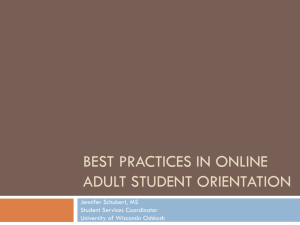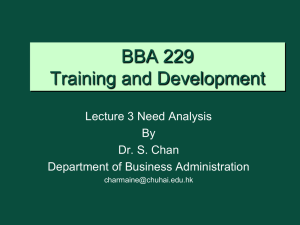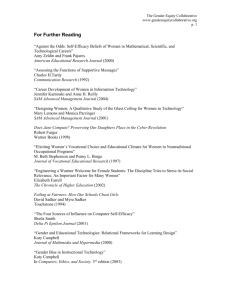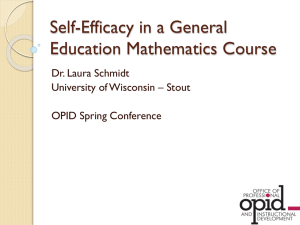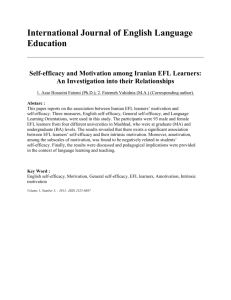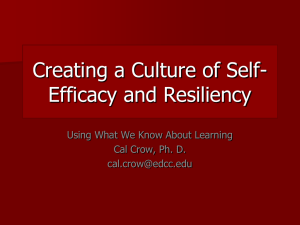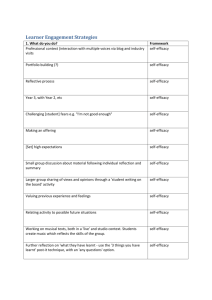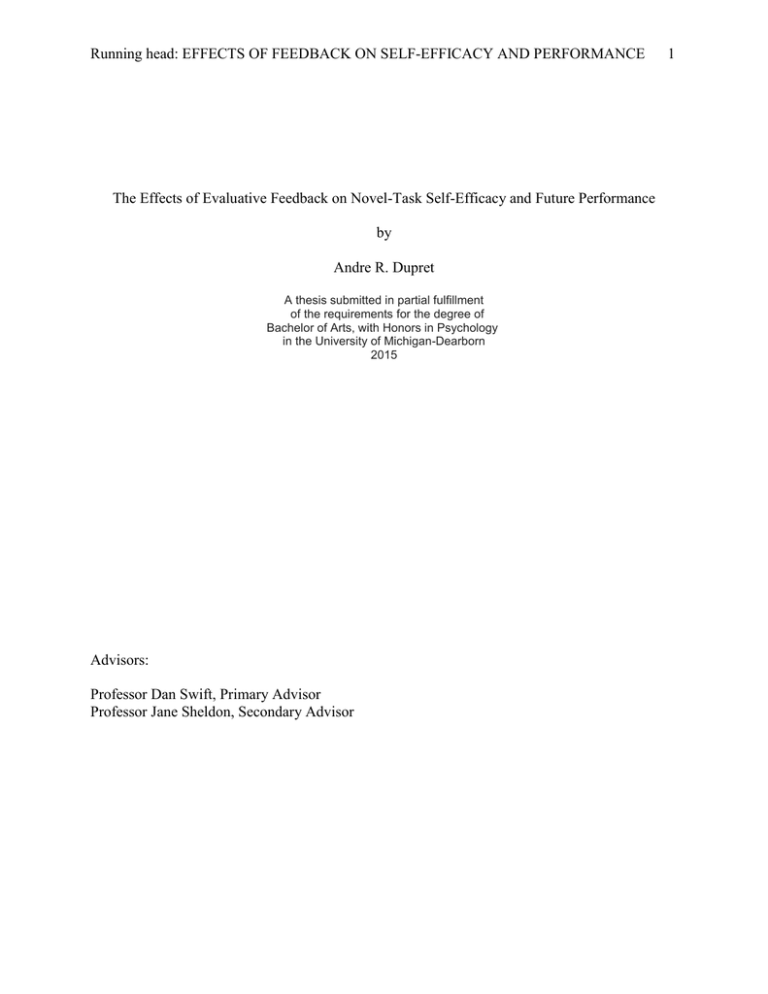
Running head: EFFECTS OF FEEDBACK ON SELF-EFFICACY AND PERFORMANCE
The Effects of Evaluative Feedback on Novel-Task Self-Efficacy and Future Performance
by
Andre R. Dupret
A thesis submitted in partial fulfillment
of the requirements for the degree of
Bachelor of Arts, with Honors in Psychology
in the University of Michigan-Dearborn
2015
Advisors:
Professor Dan Swift, Primary Advisor
Professor Jane Sheldon, Secondary Advisor
1
2
EFFECTS OF FEEDBACK ON SELF-EFFICACY AND PERFORMANCE
Abstract
There is a significant amount of research in the literature that has explored the effects of
evaluative feedback on an individual’s self-efficacy and performance on a familiar task, yet there
is little that has investigated the extent to which feedback can also impact these variables on
novel tasks. Therefore, this study endeavored to shed light on this. To do this, a procedure was
utilized in which participants with little to no experience with logical reasoning activities learned
how to play Sudoku and attempted to correctly fill in as many beginner-level 6 X 6 puzzle spaces
as they could in a specified amount of time and then, after receiving a type of feedback (positive,
normative, negative), did this again. In order to assess self-efficacy, these participants were
asked to complete the Self-Efficacy Distance Scale before their first attempt at the Sudoku
puzzles and again after they received their respective feedback. No significant differences were
found for any of the feedback groups on the variable of performance. However, it was
discovered that the positive feedback group experienced significant increases in self-efficacy in
comparison with the normative group and that the negative feedback group experienced
significant decreases in self-efficacy in comparison with it. As a result of carrying out this study
and attaining these results from it, it can be concluded that individuals can become more
efficacious about their ability to perform a novel task if they are exposed to the task in an
encouraging environment.
Keywords: feedback, self-efficacy, performance, novel
3
EFFECTS OF FEEDBACK ON SELF-EFFICACY AND PERFORMANCE
The Effects of Evaluative Feedback on Novel-Task Self-Efficacy and Future Performance
The variable of evaluative feedback has long been a focus of psychological research. This
is because evaluative feedback - feedback that judges actions but does not provide instruction for
improvement - plays an integral role in determining outcomes in many different focus areas and
contexts. However, its impact in the areas of performance and self-efficacy is to be the focus of
this literature review. In regards to this impact, it may be possible that this type of feedback can
serve as a reason for why there are times people may feel efficacious that they will perform their
respective tasks or skills flawlessly and subsequently do perform them well, and others that they
do not feel efficacious about their upcoming performances and then cannot even seem to execute
the basics of the given skill. It may also be able to account for why there are varying levels of
performance quality and self-efficacy among individuals of similar talent.
Much research has been conducted in the domain of this sub-topic in order to explore
this, and has demonstrated that evaluative feedback is indeed a very influential factor in shaping
how well one performs - and believes one can perform - on a subsequent performance of a given
task. Feedback may impact individuals’ subsequent performances and expectations because it
causes them to subconsciously impose psychological limitations on themselves. It is often the
case, however, that there is a significant discrepancy between their psychological and physical
limitations. This explains why scientists’ discouragement was the reason that no runner before
Roger Bannister was able to run - or believed they were able to run - the mile in under four
minutes (Mariano, 1999). The findings of a majority of the relevant empirical studies have
generally followed along these lines. Although a few studies have had contrary findings
(Kannappan, Yip, Lodhia, Morton, & Lau, 2012; Dusek & O’Connell, 1973; Podsakoff & Farh,
1989) it has generally been found that those who receive positive feedback enjoy greater success
4
EFFECTS OF FEEDBACK ON SELF-EFFICACY AND PERFORMANCE
on a subsequent performance while those who receive negative feedback perform worse on their
subsequent attempt. As well as this, it has also generally been found that those who receive
positive feedback experience higher self-efficacy while those who receive negative feedback
experience lower self-efficacy. Therefore, the present review will focus on discussing the studies
that have attained these findings. Such studies have conducted their research in a variety of
different contexts/settings. These contexts are education, employment, and sports/motor skills.
Context of Education
A number of studies that have been conducted in the context of education have provided
support for these feedback-self-efficacy and feedback-performance findings. Some of the studies
have conducted correlational research on them, while others have attempted to identify causality
through the use of an experiment. In regards to correlation, the studies that exist have primarily
investigated the relationship between feedback and self-efficacy. Such a study is by Arslan
(2012). In this one, 1049 middle school students self-reported on both the degree to which they
had previously been verbally persuaded (or in other words, encouraged) and their self-efficacy.
This researcher found that verbal persuasion was a significant positive predictor of self-efficacy.
Correlational studies are indeed revealing and pertinent, but to see if there are causal
relationships it is necessary to examine research that has controlled for possibly-confounding
variables. These studies have assessed the effects of different types of feedback through the use
of a between-subjects, within-subjects, or mixed design. In regards to the impact of feedback on
performance, the first study to discuss is the one carried out by Clair and Snyder (1979), in
which college students were randomly assigned to groups and listened to audio-taped lectures
that varied in the type of evaluative feedback given. After the lectures, the students took an exam
on the material that they had just learned. It was found that exam scores were highest for the
5
EFFECTS OF FEEDBACK ON SELF-EFFICACY AND PERFORMANCE
students who listened to the instructor that gave positive feedback. Another one, by Plakht,
Shiyovich, Nusbaum, and Raizer (2013), provided nursing students with either positive or
negative feedback during their clinical practice. Those that received favorable remarks from their
teachers went on to obtain higher grades than those whose efforts were met with criticism.
There is also a supportive experiment that has measured self-efficacy. This is the one by
Baron (1988). In this study, 106 undergraduates complete both a proofreading and a clerical task.
After the first completion of these tasks, these participants were asked to self-report how
efficacious they felt about performing them. They were subsequently given either constructive
feedback, destructive feedback, or no feedback on their performances. After this, they were
asked to self-report how efficacious they felt about the prospect of performing the two tasks
again. It was found that the group that had been provided destructive feedback reported
significantly lower levels of self-efficacy than did those in the other two groups.
Context of Employment
Aside from the studies that have investigated how academic performance is affected,
there are others that explore how feedback impacts work-related self-efficacy and performance.
These include both correlational and experimental studies. A correlational study that supports the
relationship between feedback and performance is that by Brown, Oubre, and Chakrabarty
(2008). In it, salespeople self-reported the extent to which they believed that their supervisors
behaved in a positive and encouraging manner towards them. Participants’ survey responses
were then matched up and compared with their sales performance at their companies. After
assessing and analyzing their results, the researchers found that the degree to which supervisors
acted in an encouraging manner did indeed positively correlate with their employees’
performance.
6
EFFECTS OF FEEDBACK ON SELF-EFFICACY AND PERFORMANCE
In regards to the studies that investigate how feedback and self-efficacy relate to each
other, there is a particularly relevant one that was carried out by Maertz, Bauer, Mosley,
Posthuma, and Campion (2005). These researchers wanted to see how well pass/fail feedback among other variables - predicted the employment testing self-efficacy of 287 job applicants at a
utility company. These applicants were assessed for self-efficacy before and after the testing, and
again after receiving either pass or fail feedback. It was found that lower self-efficacy scores
were reported by those that had been given “fail” feedback and that higher self-efficacy scores
were reported by those that had been given “pass” feedback. Another study investigated how 12
elementary teachers’ self-efficacy for teaching science related to positive verbal persuasion. The
results suggest that this type of verbal persuasion did indeed correlate positively with teachers’
efficacy for teaching science (Palmer, 2011).
As well as correlational studies, there is an experiment that has been carried out in this
context of employment that lends support to the feedback-self-efficacy finding. This is the one
by Reynolds (2006). In it, 296 employees completed a measure that measured their job-specific
self-efficacy before and after receiving a type of feedback from their respective supervisors.
Some received positive feedback, while others received negative feedback. Analyses revealed
that positive feedback had a significant positive effect on self-efficacy and that negative
feedback had a significant negative effect on self-efficacy.
Other research has instead investigated the impact of feedback on actual performance.
This includes a study (Crawford, Thomas, & Fink, 1980) in which sailors on a navy ship were
randomly divided into three groups. The sailors in all three groups were asked to perform their
duties. One of these groups - the experimental group - received positive encouragement and
7
EFFECTS OF FEEDBACK ON SELF-EFFICACY AND PERFORMANCE
affirmation every time they partook in a favorable behavior change. The researchers ultimately
found that the experimental group had the greatest improvement differences.
Context of Sports and Motor Skills
Beside from these studies that have assessed the effects of feedback on work-related selfefficacy and performance, there is also research that has investigated the effects of the variable in
the context of sports and motor skills. The correlational studies that have been carried out in this
context primarily investigate the strength and direction of the relationship between feedback and
self-efficacy. One of these studies was performed by Valiante and Morris (2013). These
researchers assessed the relationship between verbal persuasion from others and self-efficacy by
interviewing 12 male golfers. They discovered that the two variables were positively correlated.
In addition, Vargas-Tonsing (2009) assessed the impact of an emotionally-moving pre-game
speech on 151 competitive soccer players’ self-efficacy. In order to do this, the researcher had
the participants complete a survey that measured their self-efficacy both before and after their
respective coach gave them a speech. A repeated measures regression analysis indicated that
there was a moderate positive correlation between speech positivity and players’ self-efficacy.
There are also experimental studies within this context of sports and motor skills that
must be considered. Looking at the ones that pertain to the feedback-performance finding, there
are several that are noteworthy. Coffee and Rees (2011) asked participants to complete a dartthrowing task while blind-folded. Following participants’ completion of the task, they were
given false negative feedback and asked to complete the task again. The researchers found that
they performed notably worse on their second try. In another study, 10-year-old children were
asked to complete a throwing task and were then given either false positive feedback (the
experimental group) or truthful feedback (the control group). It must be noted that the feedback
8
EFFECTS OF FEEDBACK ON SELF-EFFICACY AND PERFORMANCE
was provided in the form of social-comparisons. Upon receiving their feedback, the participants
performed the task again. After comparing and analyzing the performance scores of the two
groups, the researchers discovered that the children in the positive condition were more accurate
on their second attempt than those in the control condition were (Ávila, Chiviacowsky, Wulf, &
Lewthwaite, 2012). The study performed by Saemi, Porter, Ghotbi-Varzaneh, Zarghami, and
Maleki (2012) must also be discussed. The researchers in this one asked 24 young adults to
complete a task that involved throwing a tennis ball with their non-dominant hand and trying to
hit a target - all while wearing vision-distorting goggles. Each participant performed blocks of
trials. Some were only provided with knowledge of their performance on a given trial when they
had done well, and others were updated only if they had performed poorly. A day later, the
participants from both groups completed the blocks for a second time. This time, however, they
were not provided with knowledge of their results. The researchers ultimately found that the
positive feedback group performed better on the second attempt and that the negative feedback
group performed worse on it.
There is evidence that supports the feedback-self-efficacy finding as well. This comes
from the aforementioned study by Saemi et al. (2012). The 24 young adults who completed
blocks of trials of throwing a tennis ball were asked to complete the Self-Efficacy Scale before
and after receiving either positive or negative feedback on their performances. The researchers
found that those who were provided with knowledge of their performance quality only after
successful trials had significantly higher levels of self-efficacy than did those who were provided
with knowledge of it only after unsuccessful trials.
Focus of the Present Study
9
EFFECTS OF FEEDBACK ON SELF-EFFICACY AND PERFORMANCE
In a great number of these studies, however, participants were at least somewhat familiar
with the tasks they performed. However, it has still not been thoroughly investigated whether or
not evaluative feedback has an effect on their ability and perception of their ability to perform a
completely new task. Obviously, when people have performed particular tasks many times, they
get a sense of their own abilities on them. This influences how successful they are and believe
they are going to be in subsequent performances. However, if people are new to a task and are
given feedback, it is intuitive to think that the feedback would not substantially impact their selfefficacy and subsequent performance on a task because they would not yet have a definite sense
of their aptitude. In other words, they 1) could potentially be more open-minded about their true
potential and feel that it is too early in the learning process to draw any absolute conclusions and
2) could lack an accumulation of past experiences that would facilitate their affirmation of a
particular type of feedback. However, it may be the case that individuals’ self-efficacy and
performance on a new task is significantly influenced by feedback. Were this to be the case, it
would mean that feedback impacts these variables from even the earliest stage of learning.
Although there are some studies that have investigated this, the tasks that have been utilized in
their respective procedures have been somewhat related to activities that participants would have
had experience with in the past. For example, in the study carried out by Ávila et al. (2012),
children were asked to complete a novel type of throwing task. It is more than likely though that
many of these children had thrown a ball before, especially if they had previously participated in
sports such as baseball and football. As a result, the task could not have been completely novel
for many of the participants. That there is a lack of construct validity in studies that explore the
impact of feedback on novel tasks suggests that such research has not been able to accurately
assess these relationships. Therefore, this study strived to accurately investigate this and thus
10
EFFECTS OF FEEDBACK ON SELF-EFFICACY AND PERFORMANCE
make the literature on this topic more comprehensive. In line with the findings of many of the
studies previously discussed, it was hypothesized that those who received positive feedback on
their performance on a novel task would indeed experience significant increases in future
performance quality and self-efficacy, and that those who received negative feedback would
indeed experience significant decreases in future performance quality and self-efficacy.
Method
Participants
This study utilized a sample size of 69 participants. This sample consisted of students
from the University of Michigan-Dearborn that were enrolled in a psychology course. They were
recruited through the University’s research participation system. Of these participants, 39
(56.52%) were female and 30 (43.48%) were male. The purpose of utilizing an approximately
equal number of females and males in this study was to control for the confounding variable of
males having, on average, higher levels of self-efficacy than females. It is important to note that
participants had been pre-screened to ensure that they did not have any prior experience with
Sudoku puzzles and little to no prior experience with logical puzzles in general. To be prescreened, participants were asked: “Have you ever done Sudoku puzzles?” and “Would you say
that you have little to no experience with doing logic/mathematical puzzles (Fencing Numbers,
Linking Bridges, etc.)?”
Materials and Measures
The materials used to carry out this study consisted of multiple beginner-level 6 X 6
Sudoku puzzles (see Appendix for an example puzzle), solutions to these puzzles, Sudoku puzzle
instructions, a “bogus” chart of performance scores, an Apple iPhone, and an original 304.8millimeter Self-Efficacy Distance Scale. This scale was simply a horizontal line that assessed the
degree to which participants believed in their ability to perform well on future sets of Sudoku
11
EFFECTS OF FEEDBACK ON SELF-EFFICACY AND PERFORMANCE
puzzles. The exact question used to assess this was: “How confident do you feel about your
upcoming task attempt?” The left-hand endpoint of this line represented “Low self-efficacy” and
was given a marking of “0” millimeters while the right-hand endpoint represented “High selfefficacy” and was given a marking of “304.8” millimeters.
Design
In this study, the dependent variables were the total number of digits correctly filled in
across all Sudoku puzzles attempted, as well as the scores on the measure of self-efficacy. The
independent variables were: type of feedback (positive, normative, negative) and testing time
(time 1, time 2). Type of feedback was a between-subjects variable, while testing time was a
within-subjects variable. Therefore, this study utilized a 3 X 2 mixed design. This means that
there were three feedback groups (positive, normative, negative) that were measured on their
self-efficacy and performance at two different points in time: Before the feedback (time 1) and
after the feedback (time 2).
Procedure
Participants dedicated up to 1 hour of their time to participant in the study. First, they
were allocated 2 minutes to read over and sign the informed consent form. It must be noted that
they were also given the opportunity to ask any clarification questions at this time. Subsequently,
participants were taught by the researcher how to play Sudoku. They were allocated up to 30
minutes to become comfortable with performing the task. This learning period consisted of 1)
reading the rules of the game, 2) watching the researcher complete a puzzle while listening to
him/her explain how it was being completed, and 3) completing a puzzle under the supervision
of the researcher. This helped to make certain that participants knew how to perform the task
correctly. And it is imperative that they did because they may otherwise have become stuck on
12
EFFECTS OF FEEDBACK ON SELF-EFFICACY AND PERFORMANCE
the very first puzzle and/or filled in random numbers to make it look like they were making
progress in their attempts. This would ultimately have led to the collection of nonsensical data. It
must also be noted that the length of this learning period inevitably varied from person to person,
as some were naturally more skilled than others. In order to make it difficult for participants to
know how quickly they acquired the skill, the researcher did not tell the participants 1) how
much time they were to be allocated to learn, 2) how long they actually took to learn, and 3) how
long it took other participants to learn. This was important to do because the participants could
not be allowed to get a real sense of how well they actually performed. If they had been able to,
it would have rendered the false feedback that was to follow later in the procedure not-believable
and meaningless. Following this learning period, participants were asked to indicate on the SelfEfficacy Distance Scale how confident they felt about their upcoming first attempt. They were
allocated exactly 45 seconds to do this.
Next, they were told that their work was to be checked on both of their upcoming task
attempts. At this point in the procedure, the researcher briefly showed the participants the
solutions to the puzzles. This served to make them believe that their puzzles would indeed be
checked for accuracy. It was important for participants to know that their work would be checked
because it provided them with motivation to actually follow the directions and not simply fill in
the puzzles with random numbers to get finished quickly.
After being shown the solutions to the puzzles, participants actually engaged in the task
for the first time. Their objective was to correctly fill in as many spaces of ten 6 X 6 beginnerlevel Sudoku puzzles as they could in a 9-minute period. To correctly perform the game of
Sudoku, participants had to write the numbers “1” through “6” in such a way that each number
only appeared once in every grid, row, and column. The reason that they were given 10 puzzles
13
EFFECTS OF FEEDBACK ON SELF-EFFICACY AND PERFORMANCE
was so that there was no way a given participant could actually complete the task. This was
important because if participants had been able to complete the task, then they would have been
able to objectively know that they had performed the task really well. This would have been
problematic for feedback believability. Furthermore, these puzzles were beginner-level to ensure
that even those who were having difficulty with Sudoku puzzles could at least have some success
with them. And if they were enjoying some level of success, then it was much more likely that
they would believe positive feedback. It is also necessary to note that all participants received the
same set of Sudoku puzzles. This standardization facilitated more accurate comparisons of their
performances.
In order to ensure that the participants were being allocated exactly 9 minutes, the
researcher utilized the stopwatch feature on the Apple iPhone as a means to time this period. It
must be noted that they were not able to see the iPhone as they worked, as the time countdown
could potentially have been a source of distraction for them. Furthermore, these participants were
not told at the end of the 9 minutes exactly how many spaces they correctly filled in. The
reasoning behind doing this was to make sure that they could not be decisively sure about how
well they did. This ultimately aided in making the false feedback that was to follow seem more
believable and likely to be true.
Upon participants’ completion of the first Sudoku task attempt, their scores were
recorded. Subsequently, the researcher proceeded to check the puzzles participants had
completed/were in the process of completing. The researcher took exactly 2 minutes to do this
for all participants.
After this, participants were provided with a type of false feedback pertaining to the
quality of their performances. Some (n = 23) received positive feedback, some (n = 23) received
14
EFFECTS OF FEEDBACK ON SELF-EFFICACY AND PERFORMANCE
normative feedback, and others (n = 23) received negative feedback. It must be noted that all of
the participants were randomly assigned (within constraints) in regards to which type of
feedback they received so that the variability due to individual differences would likely be
roughly equal in each group. It is also relevant to note that each group contained 13 females and
10 males. If a given participant was designated to receive positive feedback then they were told:
“You, as did everyone else who has been tested, had correct completion. Let’s see how your
score compares to those of other first-time Sudoku players tested so far.” At this point, the bogus
chart of scores was utilized for the purpose of making it appear as if other participants’ scores
were actually being accessed. Subsequently, the participant was told: “Quite incredible. You
correctly filled in 8 more spaces than the average of the participants that have already been
tested. You’re a natural at Sudoku.” The bogus chart was used in exactly the same way for the
normative and negative feedback groups. However, the feedback following this was different for
these groups. If a participant was designated to receive normative feedback then he or she was
told: “Your score falls very close to the average of the participants that have already been tested.
This means that you correctly filled in approximately the same number of spaces as many of the
other first-time Sudoku players did. You’re at about the same level as many of the participants.”
And finally, a participant who was designated to receive negative feedback was told: “I’m sorry,
but you don’t appear to have done very well. You correctly filled in 8 less spaces than the
average of the participants that have already been tested. Maybe Sudoku just isn’t your game.”
Thirty seconds were allocated for the delivery of the feedback.
After participants obtained their respective false feedback, they were asked to take a
short 1-minute break. Participants were explicitly instructed to reflect on their feedback during
this break. The point of doing this was to make it more likely that the feedback would sink in.
15
EFFECTS OF FEEDBACK ON SELF-EFFICACY AND PERFORMANCE
After this brief period participants marked on the Self-Efficacy Distance Scale how efficacious
they felt about their upcoming final task attempt. They were given 45 seconds to do this. The
purpose of having participants complete the Self-Efficacy Distance Scale immediately after the
1-minute break was to ensure that any changes in self-efficacy were due to the introduction of
the feedback alone. Subsequently, they completed the puzzles again. It is important to note that
the second set of Sudoku puzzles that participants attempted to complete were slightly different
from the first set, thus ensuring that the familiarity confound was minimized. Participants’
puzzles on this second attempt were not checked during the procedure, however. The puzzles
were checked and scored at a later time. The point of telling participants that their puzzles were
going to be checked was solely to motivate them into following the rules of Sudoku on their
second attempt. Finally, the participants were debriefed in writing that their feedback had been
false. In addition, they were notified as to why it was imperative that it be as such, and that
randomly assigning them into different groups was likely to help control for their individual
differences and thus make the results more valid. They were also asked during debriefing not to
tell potential participants about the true nature of the study, as giving them such knowledge
would have greatly reduced the meaningfulness of the results. The duration of this debriefing
period was 1 minute. See Table 1 for a timetable of procedural events.
Results
A 2-way, repeated measures, factorial analysis of variance (ANOVA) with feedback type
and testing time as independent variables was conducted on participants’ performance and selfefficacy scores. It was discovered that the main effect for the within-subjects variable of testing
time (time 1, time 2) on the self-efficacy scores was not significant, F(1, 66) = .12, p = .73. The
main effect for testing time on the performance scores was also not significant, F(1, 66) = 2.48, p
16
EFFECTS OF FEEDBACK ON SELF-EFFICACY AND PERFORMANCE
= .12. The between-subjects variable of type of feedback (positive, normative, negative) was
assessed for a main effect also. It was revealed that there was a marginally-significant difference
for the self-efficacy scores, F(2, 66) = 2.69, p = .08, but a non-significant difference for the
performance scores, F(2, 66) = 1.62, p = .21.
This analysis also included an assessment of the interactions between testing time and
feedback type. The interaction between feedback type and time 2 for the performance scores
revealed a non-significant difference, F(2, 66) = .65, p = .52. The group means and standard
deviations for this analysis can be found in Table 2, while a graphical representation of the
means can be found in Figure 1. However, the interaction between feedback type and time 2 for
the self-efficacy scores was significant, F(2, 66) = 31.47, p < .001, hp2 = .49. In order to see
where this effect occurred, paired samples t-tests were conducted to compare each feedback
group’s time 1 and time 2 self-efficacy scores. It was revealed that for those who received
positive feedback, the scores on time 2 (M = 133.74, SD = 27.65) were significantly higher than
the scores on time 1 (M = 105.74, SD = 31.64), t(22) = -7.35, p < .001. For those who received
negative feedback, the time 2 scores (M = 87.48, SD = 29.60) were significantly lower than the
time 1 scores (M = 115.48, SD = 24.75), t(22) = 5.38, p < .001. However, for those who received
normative feedback, there was not a significant difference between the time 1 scores (M =
109.70, SD = 30.08) and the time 2 scores (M = 112.65, SD = 31.33), t(22) = -.51, p = .61. These
findings appear to indicate that, as compared to the normative (control) group, positive feedback
significantly increased self-efficacy and negative feedback significantly decreased it.
Furthermore, as is evidenced by the effect size of the interaction, the impact for both types of
feedback was relatively large. A graphical representation of the group means can be found in
Figure 2.
17
EFFECTS OF FEEDBACK ON SELF-EFFICACY AND PERFORMANCE
Discussion
Summary of Findings
It had been hypothesized in the introduction that positive evaluative feedback would
increase participants’ performance and self-efficacy and that negative evaluative feedback would
decrease participants’ performance and self-efficacy. Therefore, based on the above findings, the
hypothesis was only partially supported: there was a significant effect for the self-efficacy scores
but not for the performance scores. In regards to the impact of feedback on Sudoku performance,
both positive and negative feedback did not produce any significant changes in performance
quality. Clearly, these findings do not support the performance findings of many of the relevant
studies that have been reviewed, as these have generally indicated that positive feedback
increases performance and/or that negative feedback decreases it (Ávila et al., 2012; Crawford,
Thomas, & Fink, 1980; Claire & Snyder, 1979) One possible reason to account for these findings
could be that there was a flaw in the method used to measure this variable of performance. This
flaw will be discussed as part of the study’s limitations.
With respect to the impact of evaluative feedback on participants’ self-efficacy, the
findings confirmed the hypothesis in the sense that those who received positive feedback became
significantly more efficacious (in comparison with the normative feedback group) and that those
who received negative feedback became significantly less efficacious (in comparison with the
normative feedback group). These findings were largely in line with those of many of the studies
in the literature, of which provided evidence that positive feedback significantly increases selfefficacy and/or that negative feedback decreases the variable (Reynolds, 2006; Saemi et al.,
2012; Maertz et al., 2005). A possible explanation for the findings of the present study
concerning the positive feedback group is that the positive feedback influenced participants into
18
EFFECTS OF FEEDBACK ON SELF-EFFICACY AND PERFORMANCE
experiencing a happier state of mind. This emotional positivity, in turn, could have produced in
them a sense of optimism. Emotions may have also played a key part in accounting for the
results of the negative feedback group: those who received negative feedback may have been
induced into a sad and/or despondent emotional state that caused them to second-guess their
Sudoku abilities and to experience feelings of pessimism.
Practical Implications
It is necessary to explore the practical implications of this study’s findings. Because it
was affirmed that evaluative feedback significantly impacts individuals’ self-efficacy on a novel
task, teachers, supervisors, and coaches who are responsible for introducing individuals to a task
need to utilize feedback in a productive way. Specifically, they should most likely praise
individuals when they perform an aspect of a new task well (giving them positive feedback) and
not be overly critical when they do not (by giving them negative feedback). If individuals are
made to feel that they have potential to perform well on a task, they are generally more likely to
keep practicing it. If they lack this belief, however, they will likely become despondent and not
attempt it again. Thus, even though this study failed to affirm that feedback impacts novel-task
performance, if individuals become efficacious through feedback then they are likely going to
keep practicing to the point that they end up improving their skill.
Strengths and Limitations
These findings must be considered in light of the study’s strengths and limitations. First,
the strengths will be discussed. A major one is that this study had the ability to demonstrate
whether positive or negative feedback was more impactful than simply receiving a neutral form
of feedback. This is because unlike some studies (Plakht et al., 2013; Saemi et al., 2012), it
utilized a control group that could be used as a comparison. The inclusion of a control group also
19
EFFECTS OF FEEDBACK ON SELF-EFFICACY AND PERFORMANCE
provided the added benefit of controlling for the fact that people may inevitably experience
performance improvement simply as a result of having more practice with a task. This confound
of the practice effect would certainly have influenced the results of the study by Saemi et al.
(2012), of which only utilized positive and negative feedback groups in its repeated measures
design. Another strength of the present study is that participants most likely perceived the false
feedback to be legitimate. This can be asserted with some confidence because the feedback was
able to effect a significant change in self-efficacy. If the feedback had not been perceived as
believable, then participants likely would not have been impacted by it. A final strength is the
utilization of the Self-Efficacy Distance Scale. Because the scale merely consisted of a line that
did not contain any numbers to specify different levels of self-efficacy, when participants
assessed their self-efficacy on time 2 it was very difficult for them to simply use their marking
on time 1 as a reference point. As a result, it was possible to attain time 2 ratings of self-efficacy
that were more accurate and honest.
There are also limitations to consider, however. As briefly mentioned above, there may
have been a flaw in the methodology. Specifically, the assessment of performance may have
been compromised because Sudoku was selected as the task. This is because there were instances
in which participants were not able to comprehend how to correctly complete the puzzles
(despite the fact that these puzzles were only beginner-level). It was wrongly assumed that
college students would not have difficulty in this respect. It had been thought that they would
merely differ on the speed at which they correctly completed the puzzles. Another issue arose out
of the fact that one mistake on the task became detrimental to participants’ chances for
performance success. When participants made a mistake and did not recognize that they had
done so, they effectively guaranteed that most of their subsequent spaces would be incorrect.
20
EFFECTS OF FEEDBACK ON SELF-EFFICACY AND PERFORMANCE
And making these mistakes may have been facilitated by the fact that they were trying to
complete the puzzle spaces as fast as they could. Ultimately, this caused some participants who
did understand the task to not perform well on it. Both of these drawbacks concerning Sudoku
increased - to some degree - the amount of random error in the data set. Another limitation is that
the findings regarding the impact of positive and negative feedback on self-efficacy are not
completely generalizable. This is because much of the data was collected from college freshman.
Teenagers, who are more sensitive to feedback from others (Arnett, 2013) than are other age
groups, are more likely to react to evaluation in a more extreme manner. Therefore, it may be
that many of the participants in this study were affected by the feedback in a way that is not
representative of the population at large. A final limitation is that the present study was not able
to take full advantage of the fact that there were approximately equal numbers of males and
females in each feedback group. It was realized in hindsight that gender could have been used as
an independent variable to assess if there are significant gender differences in the way feedback
impacts performance and self-efficacy.
Directions for Future Research
Future research could potentially build on the present study by addressing these
limitations. To accurately assess novel-task performance, researchers should adopt a task that: 1)
is more straightforward and 2) does not make it a possibility that one can attain a detrimental
result through making one or two mistakes. Research should also strive to replicate the present
study’s self-efficacy findings using samples consisting of children or fully-developed adults.
This would serve to affirm the findings as well as provide an understanding of the ways in which
different groups of individuals perceive feedback. Finally, future research should systematically
21
EFFECTS OF FEEDBACK ON SELF-EFFICACY AND PERFORMANCE
assess how gender might influence the impact that evaluative feedback has on performance and
self-efficacy.
22
EFFECTS OF FEEDBACK ON SELF-EFFICACY AND PERFORMANCE
References
Arnett, J. (2013). Adolescence and emerging adulthood: A cultural approach (5th ed.). Upper
Saddle River, N.J., New Jersey: Pearson Prentice Hall.
Arslan, A. (2012). Predictive power of the sources of primary school students’ self-efficacy
beliefs on their self-efficacy beliefs for learning and performance. Kuram Ve
Uygulamada Eğitim Bilimleri, 12(3), 1915-1920.
Ávila, L. G., Chiviacowsky, S., Wulf, G., & Lewthwaite, R. (2012). Positive social-comparative
feedback enhances motor learning in children. Psychology of Sport and Exercise, 13(6),
849-853. doi:10.1016/j.psychsport.2012.07.001
Baron, R. A. (1988). Negative effects of destructive criticism: Impact on conflict, self-efficacy,
and task performance. Journal of Applied Psychology, 73(2), 199-207. doi:
10.1037/0021-9010.73.2.199
Brown, G., Oubre, D., & Chakrabarty, S. (2008). The impact of supervisory adaptive selling and
supervisory feedback on salesperson performance. Industrial Marketing Management,
37(4), 447-454. doi:10.1016/j.indmarman.2007.04.002
Clair, M., & Snyder, C. (1979). Effects of instructor-delivered sequential evaluative feedback
upon student's subsequent classroom-related performance and instructor ratings. Journal
of Educational Psychology, 71(1), 50-57. doi:10.1037/0022-0663.71.1.50
Coffee, P., & Rees, T. (2011). When the chips are down: Effects of attributional feedback on
self-efficacy and task performance following initial and repeated failure. Journal of
Sports Sciences, 29(3), 235-245. doi:10.1080/02640414.2010.531752
23
EFFECTS OF FEEDBACK ON SELF-EFFICACY AND PERFORMANCE
Crawford, K. S., Thomas, E. D., & Fink, J. J. (1980). Pygmalion at sea: Improving the work
effectiveness of low performers. Journal of Applied Behavioral Science, 16(4), 482-505.
doi:10.1177/002188638001600405
Dusek, J. B., & O'Connell, E. J. (1973). Teacher expectancy effects on the achievement test
performance of elementary school children. Journal of Educational Psychology, 65(3),
371-377. doi:10.1177/002188638001600405
Kannappan, A., Yip, D., Lodhia, N., Morton, J., & Lau, J. (2012). The effect of positive and
negative verbal feedback on surgical skills performance and motivation. Journal of
Surgical Education, 69(6), 798-801. doi:10.1016/j.jsurg.2012.05.012
Maertz, C. r., Bauer, T. N., Mosley, D. r., Posthuma, R. A., & Campion, M. A. (2005). Predictors
of self-efficacy for cognitive ability employment testing. Journal of Business
Research, 58(2), 160-167. doi:10.1016/S0148-2963(03)00111-5
Mariano, C. (1999). Smart enough to excel. Vital Speeches of the Day, 66(2), 62-64.
Palmer, D. (2011). Sources of efficacy information in an in-service program for elementary
teachers. Science Education, 95(4), 577-600. doi:10.1002/sce.20434
Plakht, Y., Shiyovich, A., Nusbaum, L., & Raizer, H. (2013). The association of positive and
negative feedback with clinical performance, self-evaluation and practice contribution of
nursing students. Nurse Education Today, 33(10), 1264-1268. doi:
10.1016/j.nedt.2012.07.017
Podsakoff, P. M., & Farh, J. (1989). Effects of feedback sign and credibility on goal setting and
task performance. Organizational Behavior and Human Decision Processes, 44(1), 4567. doi:10.1016/0749-5978(89)90034-4
24
EFFECTS OF FEEDBACK ON SELF-EFFICACY AND PERFORMANCE
Reynolds, D. (2006). To what extent does performance-related feedback affect managers' selfefficacy? International Journal of Hospitality Management, 25(1), 54-68.
doi:10.1016/j.ijhm.2004.12.007
Saemi, E., Porter, J. M., Ghotbi-Varzaneh, A., Zarghami, M., & Maleki, F. (2012). Knowledge
of results after relatively good trials enhances self-efficacy and motor learning.
Psychology of Sport and Exercise, 13(4), 378-382.
doi:10.1016/j.psychsport.2011.12.008
Valiante, G., & Morris, D. B. (2013). The sources and maintenance of professional golfers' selfefficacy beliefs. The Sport Psychologist, 27(2), 130-132.
Vargas-Tonsing, T. M. (2009). An exploratory examination of the effects of coaches' pre-game
speeches on athletes' perceptions of self-efficacy and emotion. Journal of Sport
Behavior, 32(1), 92-109.
25
EFFECTS OF FEEDBACK ON SELF-EFFICACY AND PERFORMANCE
Table 1
Timetable of Procedural Events
Event
Allocated Time
Informed consent
2 minutes
Learning how to play Sudoku
up to 30 minutes
Self-efficacy measure at Time 1
45 seconds
Task attempt 1
9 minutes
Puzzle check
2 minutes
Feedback
30 seconds
Break
1 minute
Self-efficacy measure at Time 2
45 seconds
Task attempt 2
9 minutes
Debriefing
1 minute
26
EFFECTS OF FEEDBACK ON SELF-EFFICACY AND PERFORMANCE
Table 2
Mean Performance Scores as a Function of Type of Feedback and Testing Time
Type of Feedback
Testing Time
Time 1
Time 2
Positive
Normative
Negative
50.44
54.91
42.09
(29.35)
(23.31)
(11.68)
57.52
55.78
44.87
(38.57)
(29.03)
(15.93)
Note. Numbers in parentheses represent standard deviations. Higher scores represent greater
performance success.
27
EFFECTS OF FEEDBACK ON SELF-EFFICACY AND PERFORMANCE
Figure 1
Mean Performance Scores as a Function of Type of Feedback and Testing Time
60
58
Performance Score
56
54
52
50
Time 1
48
Time 2
46
44
42
40
Positive
Normative
Type of Feedback
Negative
28
EFFECTS OF FEEDBACK ON SELF-EFFICACY AND PERFORMANCE
Figure 2
Mean Self-Efficacy Scores as a Function of Type of Feedback and Testing Time
140
Self-Efficacy Score
130
120
110
Time 1
Time 2
100
90
80
Positive
Normative
Type of Feedback
Negative
29
EFFECTS OF FEEDBACK ON SELF-EFFICACY AND PERFORMANCE
Appendix
Beginner-level 6 X 6 Sudoku Puzzle

